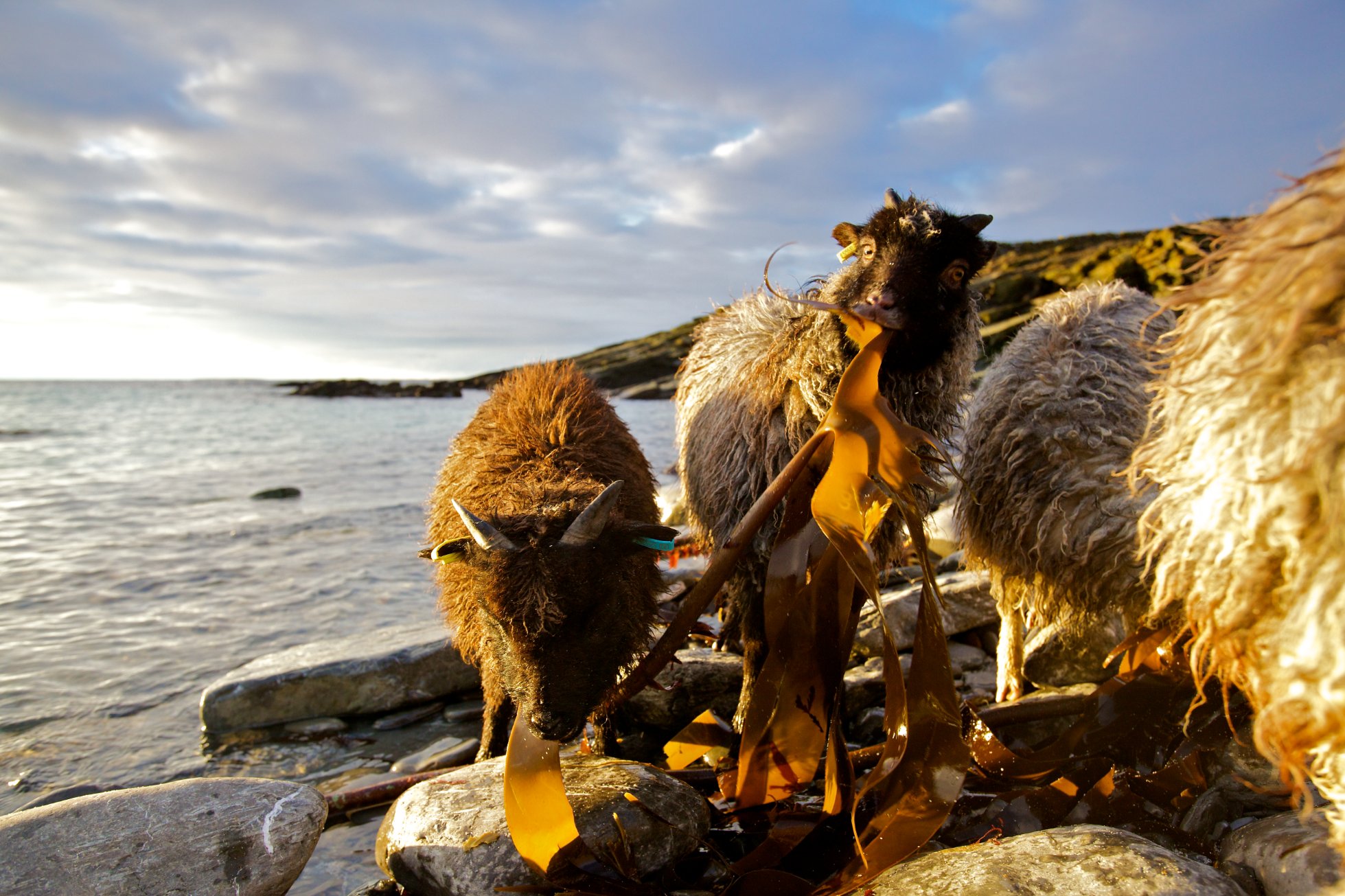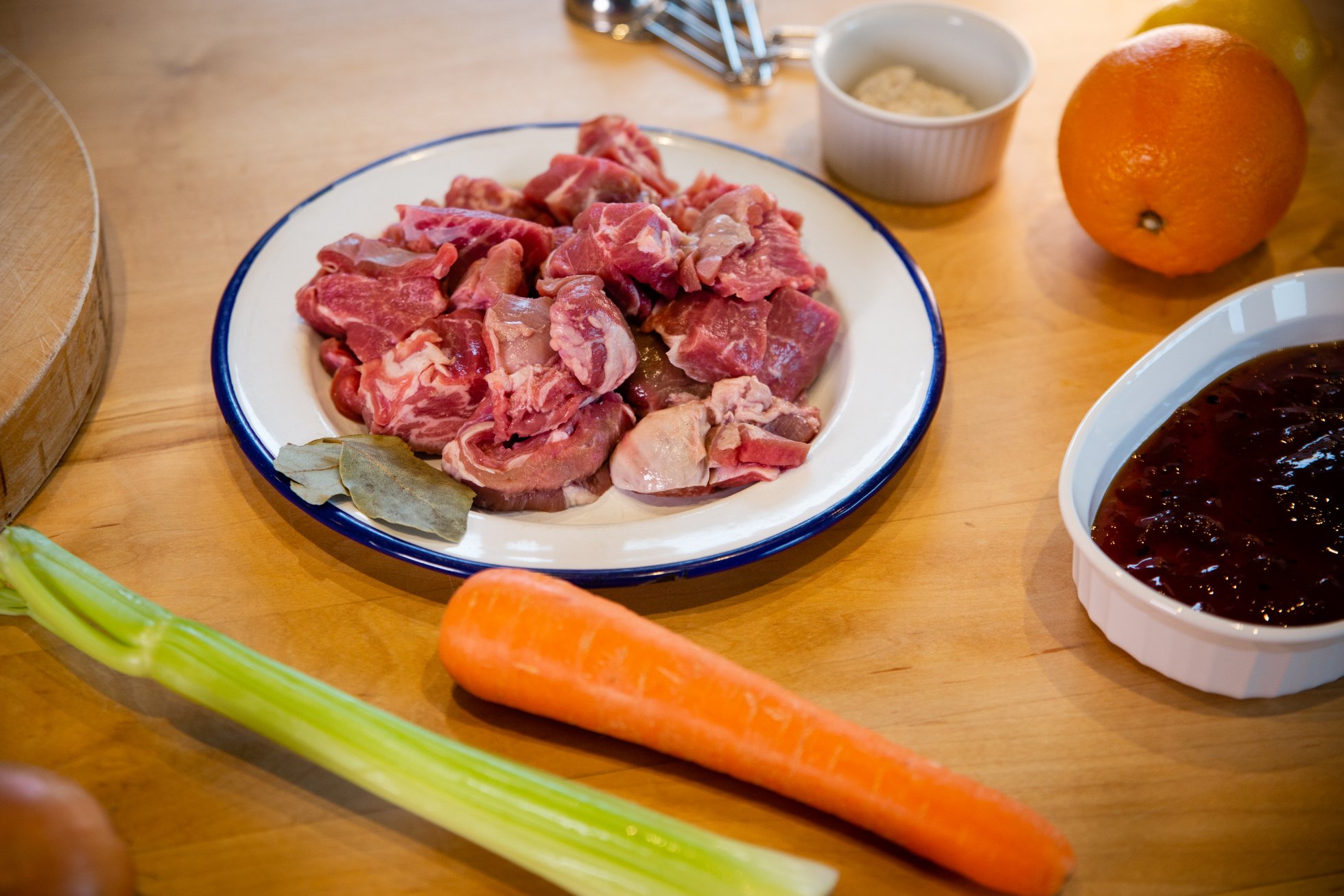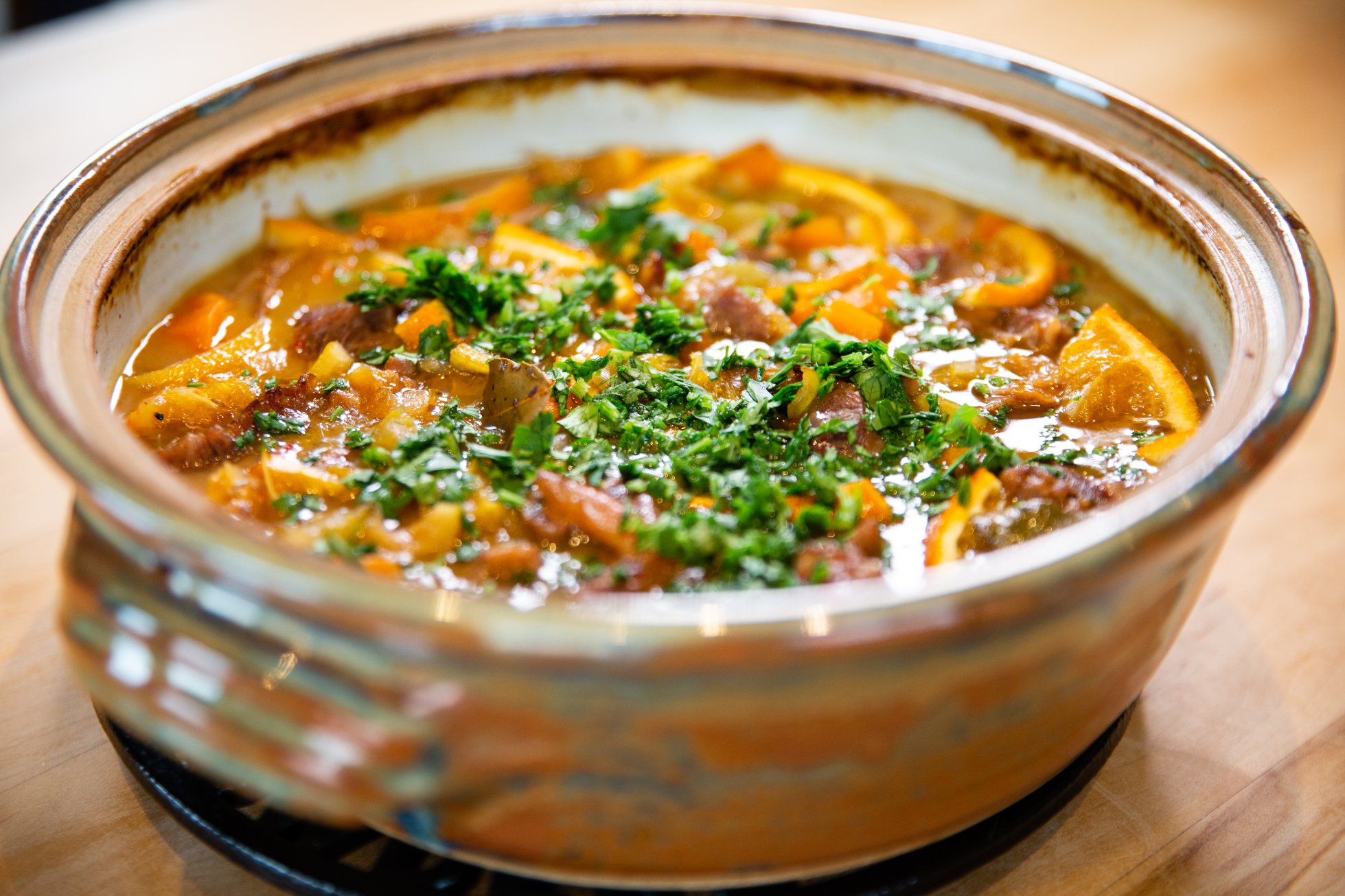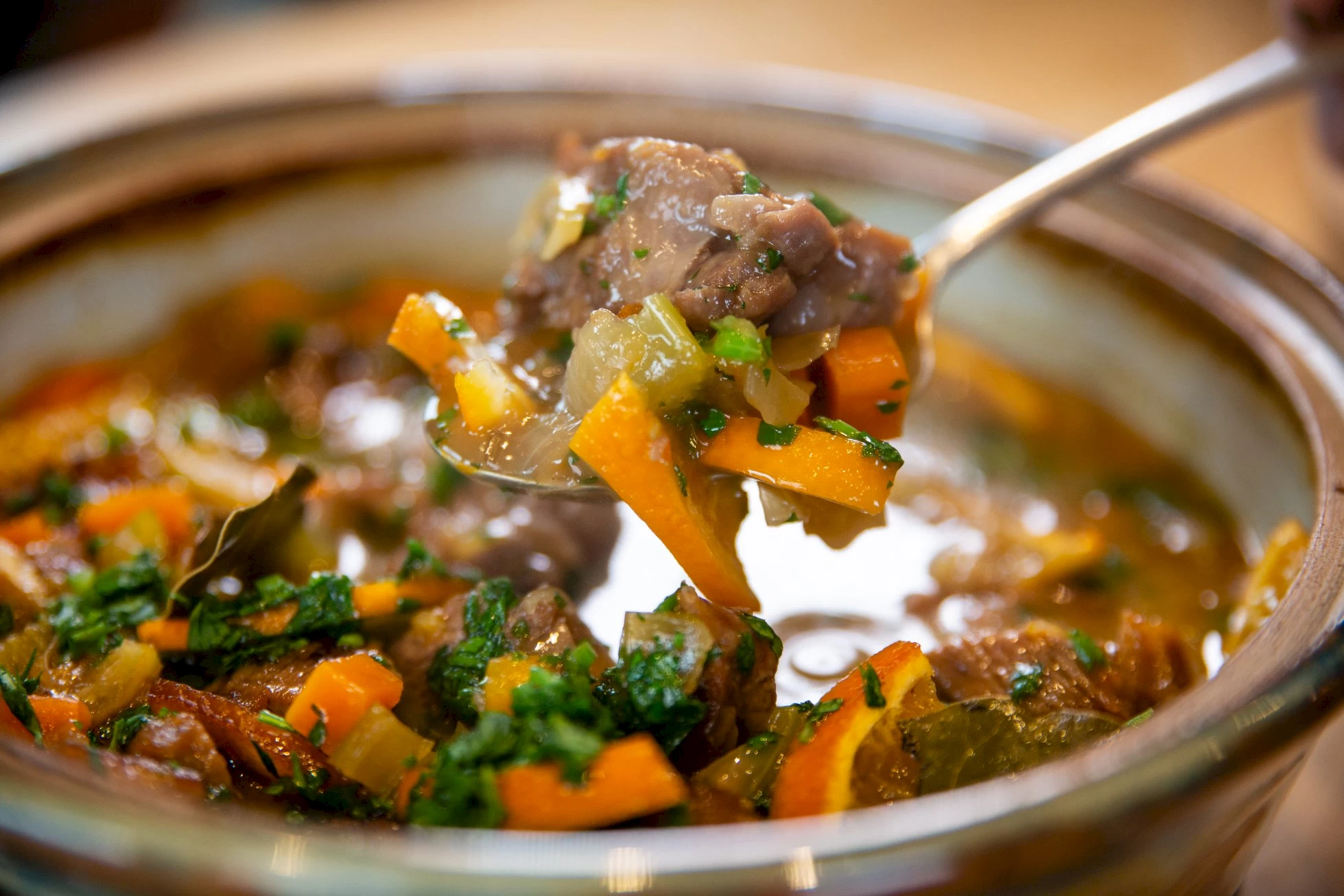Our regular food blogger Rosemary Moon has been sampling more of Orkney's finest produce this month. Keep reading to try her recipe for yourself.
Mention lamb, mutton and Orkney in the same breath and most people immediately think of North Ronaldsay. The island's celebrated and almost feral sheep, a breed thought to be possibly 8000 years old, are excluded from pastures and fields by a 13.5-mile long dyke or stone wall and feed entirely on seaweed, which gives a huge depth to the flavour of their lean meat.
However, with approximately thirty thousand breeding sheep living across Orkney’s islands, there is much more to celebrate than the rare and ancient breed of our most northern isle.
Chatting to Martyn Whyte of South Cara and Honeysgeo farms in South Ronaldsay - about as far away from North Ronaldsay as you can get in Orkney - I am immediately struck by the passion that he has for his sheep, his farm and the stewardship entrusted to him of his fields on these centuries old islands. North Ronaldsay’s sheep are feted in the foodie world but Martyn’s sheep also have a taste for seaweed, sunbathing on the beaches and enjoying a diet rich in the flora and fauna found on their coastal heath and cliff top pastures. Whilst most of his flock are Cheviots, a breed which thrives on the coastal terrain of his farms, Martyn also has a small flock of Shetland sheep, another native breed which, like his main flock, produce meat that is all about flavour.
Both breeds are well suited to today’s environmentally-aware consumers who want to eat very naturally produced, full-flavoured meat. A foodie choice that is good for the planet too.
We discuss why the Scots eat so much less lamb than the average UK consumer and Martyn suggests that it might be because we use the same word of a fluffy baby sheep as we do for the meat. That makes sense to me but it would take a massive marketing and educational campaign to change it! Here in Orkney, people who do not eat the island’s lamb sold through the brilliant specialist butchers are really missing out: I have seldom tasted such delicious meat as the lamb that I have bought here which is lean, juicy and packed full of herbaceous flavours.
Whilst the majority of the sheep in Orkney are Texels or Texel crosses, Martyn and the North Ronaldsay farmers are not the only ones doing things differently. Jane Cooper has a hugely important flock of Boreray sheep in the West Mainland, another ancient native breed which may well have been grazing when the Ness of Brodgar was in use - indeed Jane takes a few of her sheep to the Ness Open Days each summer. Slow to mature at two or three years and therefore producing delicious mutton, the Borerays also give high quality fleeces which they shed naturally without shearing. Jane has these spun into yarn which is much sought after by the highly skilled knitters of the islands. Like all the more specialist breed farmers Jane is keen to see Orkney’s abattoir reinstated in some form and is a leading campaigner to that end.
Nancy Fergus runs a flock of Zwartbles at Deerness, sending their wool to Shetland to be spun into Orkney Tweed which is then made into fashions, toys and home furnishings to be sold in her Victoria Street shop in Kirkwall. The role of sheep as a naturally reared, low impact way of producing both meat and fabrics is a tradition that is much celebrated in Orkney, with both our thriving food and craft scenes making good use of what the animals provide. In the tiny isle of Auskerry, the second most important flock of North Ronaldsay sheep anywhere provides the fleeces for a craft business that ensures Simon Brogan and Teresa Probert can continue to live and work in the island that has been their home for nearly four decades. It is the sheep providing both food and fleeces - and Simon and Teresa’s own resilience - that enables them to stay in Auskerry. We will have to wait and see if their children take over from them.
When I first started researching the best way to cook North Ronaldsay mutton I came across a recipe which suggested that it was traditionally cooked with Seville oranges - that surprised me! Since then I have heard of boxes of oranges sometimes being washed up on the beaches, but I would be amazed if that had happened often enough to give rise to a traditional recipe! Marmalade does, however, work brilliantly with the meat - the citrus flavours really accentuate the sweetness of any Orkney sheep meat, be it tender lamb or older mutton, the latter requiring a longer, slower cook. I love lamb casseroles and hope that you will enjoy this one: it will give you a very different flavour of Orkney.
Marmalamb
Ingredients
Serves 4 generously
- 1 onion
- 1 carrot
- 1 stick celery
- 2 Seville oranges or 1 orange and 1 lemon
- 500-650g diced lamb or mutton
- 1tbsp seasoned beremeal
- 1tsp olive oil
- 1tsp fennel seeds
- 2 bay leaves
- 250g well-flavoured marmalade
- 250ml orange juice
- Freshly chopped parsley to garnish
Method
- Prepare and finely dice or slice the onion, carrot and celery. Trim the ends of the citrus, quarter the fruits and remove any pips and the central core, then slice through the fruit and pith thinly, as if making marmalade.
- Toss the diced meat in the beremeal (or flour) with some salt and pepper.
- Heat the oil in a sauté pan over a medium high heat, add the meat and brown on all sides. Add the prepared vegetables with the fennel and bay. Reduce the heat and cook slowly, covered, for 5-6 minutes until the vegetables are well softened, stirring once or twice.
- Add the prepared citrus fruit with the marmalade, orange juice and some salt and pepper. Bring to the boil. You can cover the sauté pan and simmer the casserole slowly for 1 1/2 hours for lamb, or 2 1/2 hours for mutton stirring occasionally, but I prefer to cook lamb for 1 1/2 hours at Gas mark 4, 170C fan oven, or mutton at Gas mark 3, 150C fan oven for mutton. Cook in the sauté pan or an ovenware casserole, whichever you prefer.
- Season again before serving, scattered with chopped parsley. Orkney tattie mash and leeks are perfect accompaniments
 Rosemary Moon ‘retired’ to Orkney after a long association with the salmon industry in the islands. The author of 19 cookery books and countless more recipes, including writing for Waitrose and Lakeland, she has brought journalists and food writers to Orkney in the past to show off our diverse and delicious food and drink. After several holidays here Rosemary and her husband Nick have settled in South Ronaldsay but, once a cookery writer always a cookery writer, Rosemary is finding it impossible to stop jotting down the new recipes that she is creating with the island produce.
Rosemary Moon ‘retired’ to Orkney after a long association with the salmon industry in the islands. The author of 19 cookery books and countless more recipes, including writing for Waitrose and Lakeland, she has brought journalists and food writers to Orkney in the past to show off our diverse and delicious food and drink. After several holidays here Rosemary and her husband Nick have settled in South Ronaldsay but, once a cookery writer always a cookery writer, Rosemary is finding it impossible to stop jotting down the new recipes that she is creating with the island produce.
Rosemary also writes and vlogs about whisky and is particularly interested in whisky and food matching. You can follow her on Twitter, Instagram and on her rosemarymoon.com and myorkneylarder.com websites.
The Digital Orkney project has been part financed by the Scottish Government and the European Community Orkney LEADER 2014-2020 Programme.




